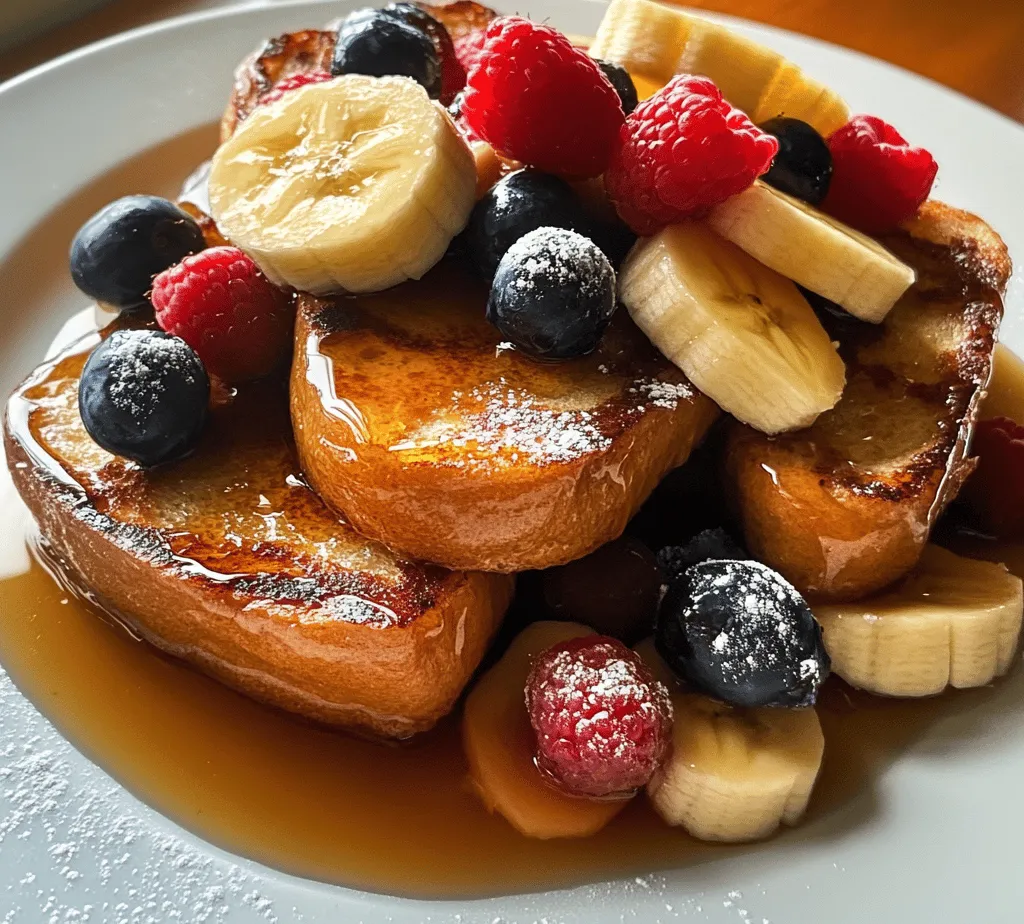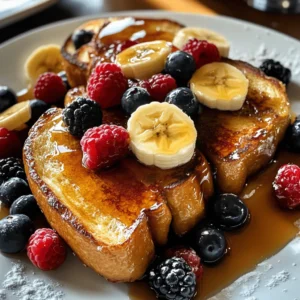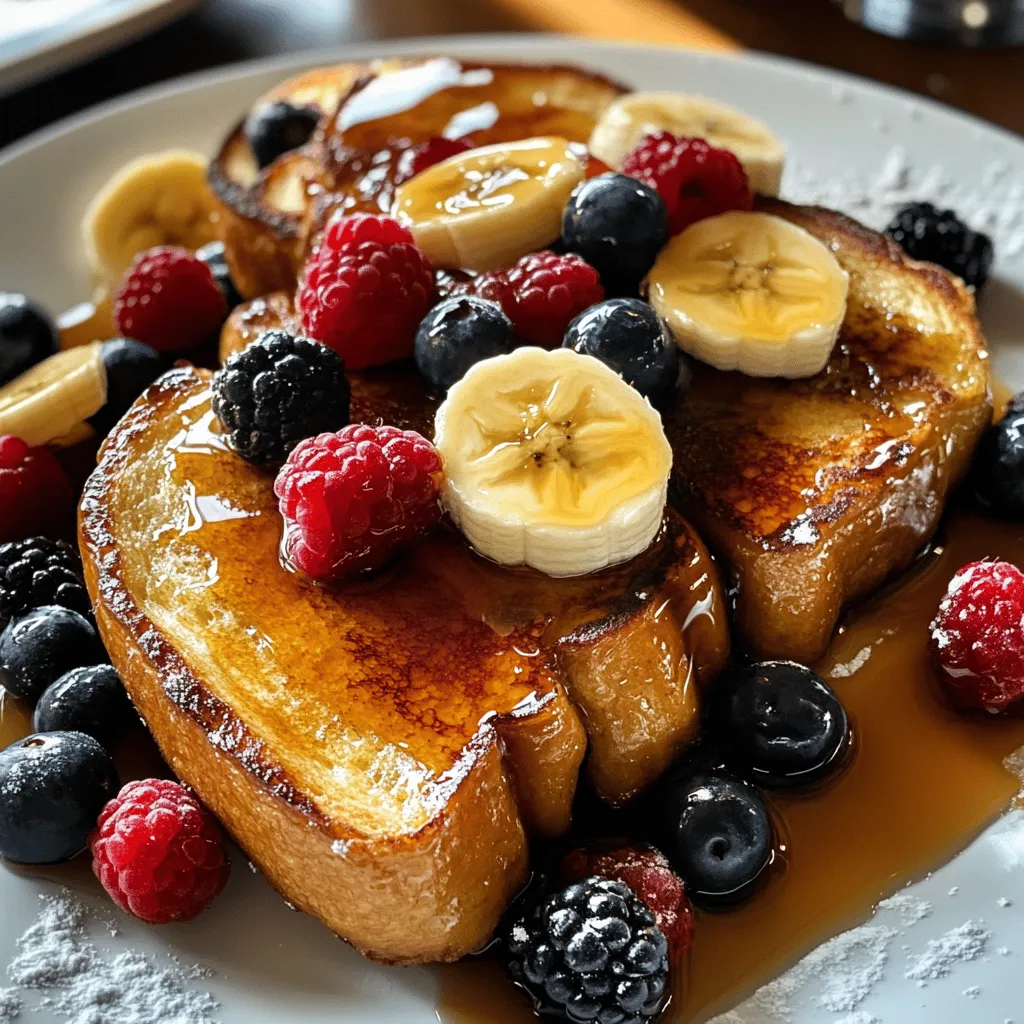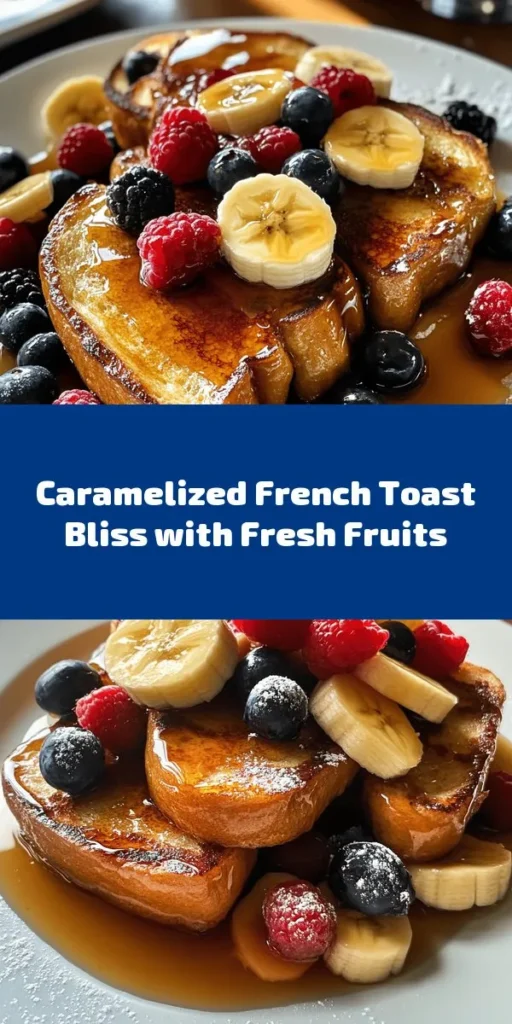Introduction to Caramelized Delight French Toast
If you’re in search of a breakfast dish that combines nostalgia with gourmet flair, look no further than the Caramelized Delight French Toast. This recipe takes the humble French toast to extraordinary heights, making it an indulgent treat suitable for special occasions or a cozy weekend brunch at home. With its rich flavors, inviting aroma, and stunning presentation, this dish is bound to impress your family and friends.
French toast has a long and varied history, dating back to ancient Roman times, where it was known as “Aliter Dulcia.” This dish was originally created as a way to utilize stale bread, soaking it in a mixture of eggs and milk before frying it until golden brown. Over the centuries, French toast has evolved and adapted, taking on numerous variations across different cultures. From the sweet and fruity versions popular in many Western countries to savory renditions found in places like China and the Middle East, the versatility of French toast knows no bounds.
The Caramelized Delight French Toast brings a unique twist by incorporating rich caramelization, fresh fruits, and a hint of spice. As we delve into the recipe, we will explore the carefully selected ingredients, step-by-step instructions, and tips to elevate your dish, ensuring that you achieve the perfect balance of flavors and textures.
Exploring the Ingredients
Understanding the components of the Caramelized Delight French Toast will enhance your cooking experience and allow you to make informed choices. Each ingredient plays a crucial role in creating the delicious result you’ll serve up.
The Foundation: Bread Choices
The bread you choose is foundational to the success of your French toast. While any bread can technically be used, certain types yield a superior texture and flavor. For the Caramelized Delight French Toast, we recommend using challah or brioche. These breads are enriched with eggs and butter, giving them a soft, pillowy texture that holds up well to soaking.
– Challah: A traditional Jewish bread, challah is slightly sweet and has a beautiful braided appearance. Its airy structure allows it to absorb the custard mixture well, making every bite deliciously custardy.
– Brioche: Known for its buttery richness and tender crumb, brioche takes French toast to a whole new level. The slight sweetness of brioche complements the caramelization process, creating an irresistible contrast.
When preparing your French toast, it’s essential to cut the bread into thick slices, typically around 1-inch thick. This thickness ensures that the bread can soak up the custard mixture without falling apart, resulting in a rich and satisfying texture when cooked.
The Egg Mixture: The Key to Flavor
The custard that coats your bread is what truly makes French toast shine. For the Caramelized Delight French Toast, the egg mixture consists of:
– Eggs: The primary binding ingredient, eggs provide structure and richness to the custard. They also contribute to the golden-brown color during cooking.
– Milk: Whole milk is ideal for a creamy texture, but you can also substitute with almond milk or oat milk for a dairy-free option. The milk adds moisture to the custard, creating a luscious coating for the bread.
– Vanilla Extract: A splash of pure vanilla extract elevates the flavor profile, imparting a warm, sweet aroma that enhances the overall dish.
– Ground Cinnamon: This fragrant spice adds warmth and depth to the custard, complementing the sweetness of the caramelized elements.
– Salt: Just a pinch of salt balances the sweetness and enhances all the flavors in the custard.
Combining these ingredients creates a rich and creamy custard that perfectly clings to the bread, infusing each bite with flavor.
The Sweet Element: Brown Sugar and Butter
One of the standout features of the Caramelized Delight French Toast is its delightful caramelization. This is achieved through the use of brown sugar and butter in the cooking process.
– Brown Sugar: The molasses content in brown sugar not only adds sweetness but also brings a deep, caramel-like flavor that complements the dish beautifully. As it melts during cooking, it forms a sweet syrup that coats the bread and creates a delicious crust.
– Butter: Butter is essential for frying the French toast, providing richness and preventing sticking. It also aids in the caramelization process, helping to create that beautiful golden-brown exterior. For a deeper flavor, consider using unsalted butter and adding a touch of salt to the caramel.
The combination of brown sugar and butter not only enhances the dish’s flavor but also contributes to its appealing texture, resulting in a delightful contrast between the soft, custardy interior and the crispy, caramelized exterior.
Toppings That Elevate the Dish
While the Caramelized Delight French Toast is delicious on its own, the right toppings can elevate it to an extraordinary level. Fresh fruits and pure maple syrup are among the best companions for this dish.
– Fresh Fruits: Seasonal fruits such as bananas, strawberries, blueberries, or peaches add a burst of freshness and natural sweetness. Not only do they enhance the flavor, but they also provide a beautiful visual contrast against the caramelized toast. For a delightful twist, consider lightly sautéing the fruits in a pan with a bit of butter and brown sugar for an extra indulgent topping.
– Maple Syrup: A drizzle of high-quality pure maple syrup is a must. Its rich, complex sweetness complements the caramelized flavors and adds a luxurious touch. For an even more decadent experience, warm the syrup slightly before serving to enhance its aroma and flavor.
Incorporating these toppings not only enhances the overall flavor profile but also makes for a stunning presentation that is sure to impress your guests.
Step-by-Step Cooking Instructions
To ensure a successful cooking experience, detailed instructions will guide you through each stage of preparing this delightful dish.
Preparing the Egg Mixture
1. Gather the Ingredients: Start by gathering all the ingredients for the custard mixture—eggs, milk, vanilla extract, ground cinnamon, and salt.
2. Whisk Together: In a large mixing bowl, crack the eggs and whisk them until they are well beaten. Add in the milk, vanilla extract, ground cinnamon, and a pinch of salt. Continue whisking until all the ingredients are thoroughly combined and the mixture is smooth.
3. Achieving the Right Consistency: The custard should be creamy and well-blended, with no lumps of egg remaining. If necessary, use a hand mixer to ensure a silky texture.
Soaking the Bread
1. Prepare the Bread: Slice your chosen challah or brioche bread into 1-inch thick slices. Lay them out on a baking sheet or plate.
2. Soaking Time: Dip each slice of bread into the egg mixture, allowing it to soak for about 30 seconds on each side. This soaking time is crucial as it ensures the bread absorbs enough custard to become rich and flavorful without becoming overly soggy.
3. Avoiding Sogginess: After soaking, gently shake off any excess custard before placing the bread on a separate plate. This step will help prevent the bread from becoming too soggy and falling apart during cooking.
Creating the Caramel
1. Heat the Pan: In a large skillet or griddle, melt a generous amount of butter over medium heat. Ensure the pan is hot enough before adding the bread—this will help create a nice caramel crust.
2. Add Brown Sugar: Once the butter has melted, sprinkle a layer of brown sugar evenly over the surface of the pan. Allow it to melt slightly, creating a sweet, sticky base for the bread.
3. Cooking the Bread: Carefully place the soaked bread slices onto the caramelized surface of the pan. Cook for about 3-4 minutes on each side, or until golden brown and caramelized. Keep an eye on the heat; if the caramel starts to burn, reduce the temperature.
4. Flipping Technique: Use a spatula to gently lift and check the underside of the bread. When it reaches a deep golden color, flip it to cook the other side.
As you prepare the Caramelized Delight French Toast, you will find that the aroma fills your kitchen, making it hard to resist the temptation to dive in. Each step of the process builds upon the last, ensuring that your final dish is not only visually appealing but also bursting with flavor. Stay tuned for the next part, where we will explore tips for serving this delightful dish, ensuring it is a hit at your next brunch gathering.

Melting Butter and Incorporating Brown Sugar
To begin crafting your Caramelized Delight French Toast, you’ll need to create the luscious caramel base that sets this dish apart. Start by placing a non-stick skillet over medium heat. Once the skillet is warm, add in a generous two tablespoons of unsalted butter. It’s essential to allow the butter to melt completely, creating a creamy and smooth base for the sugar.
Once your butter has melted, gradually sprinkle in half a cup of packed brown sugar. The choice of brown sugar is crucial, as it brings a rich molasses flavor that complements the toast beautifully. Stir the mixture continuously with a wooden spoon or spatula, making sure that the sugar fully incorporates into the melted butter.
As you stir, you’ll notice the mixture beginning to bubble gently. This bubbling indicates that the caramel is forming. However, it’s vital to monitor the heat carefully at this stage; too high a temperature can cause the sugar to burn, resulting in a bitter taste that will overshadow the sweetness you want in your French toast. Maintain the heat at a medium-low setting and continue stirring until the sugar has completely dissolved and the mixture takes on a glossy, syrupy consistency, which should take about 2-3 minutes.
Cooking the French Toast
With your caramel mixture ready, it’s time to cook the French toast. Begin by preheating your skillet over medium heat. You want the skillet to be hot enough to create a nice sear on the bread but not so hot that it burns the caramel.
While the skillet heats, take your slices of bread—ideally, thick-cut brioche or challah for the best texture—and dip them into your egg custard mixture. Allow each side to soak for about 20 seconds, ensuring the bread absorbs enough custard without becoming overly soggy.
Once the skillet is hot, pour the caramel mixture evenly over the bottom. Allow it to spread naturally, creating a sweet foundation for your French toast. Next, carefully place your soaked slices of bread onto the caramel. Cook each side for approximately 3-4 minutes. You’ll know it’s time to flip the bread when the edges start to turn a golden brown and the caramel begins to bubble around the sides.
For flipping, gently slide a spatula underneath one slice of bread. It’s best to do this with a swift motion to minimize any splatters of hot caramel. Once flipped, allow the opposite side to cook for another 3-4 minutes, ensuring that both sides are beautifully golden and the caramel has thickened around the edges.
Serving Suggestions
Plating Techniques
Presenting your Caramelized Delight French Toast is just as important as preparing it. For an eye-catching display, start by stacking two slices of the caramelized toast on a plate. Consider adding a light dusting of powdered sugar on top for an elegant touch.
To enhance the visual appeal, you can create a colorful fruit medley. Freshly sliced bananas, strawberries, or blueberries not only add vibrant colors but also offer a refreshing contrast to the richness of the caramel. Arrange the fruits artfully around the toast or on top, allowing them to cascade down the sides for a rustic yet refined look.
Next, drizzle warm maple syrup over the top, allowing it to pool slightly on the plate. This adds a touch of shine and further enhances the dish’s inviting appearance.
Pairing Beverages
The right beverage can elevate your Caramelized Delight French Toast experience. A freshly brewed cup of coffee, whether it be a classic drip, French press, or espresso, complements the sweetness of the dish beautifully. Consider offering a flavored coffee, such as vanilla or hazelnut, to add an additional layer of flavor.
Alternatively, freshly squeezed juices like orange or apple provide a bright, refreshing counterpoint to the rich caramel. For a more indulgent experience, a creamy latte or cappuccino can also be an excellent choice, enhancing the overall brunch experience.
The History and Variations of French Toast
French toast has a long and varied history that dates back to ancient times. The earliest known recipe can be traced back to the Roman Empire, where bread was soaked in a mixture of milk and eggs to prevent waste. This culinary innovation gradually made its way through various cultures, leading to the beloved breakfast dish we know today.
Different countries have their unique takes on French toast. In Spain, for instance, “Torrijas” is a traditional dish typically served during Holy Week, made with stale bread soaked in milk and flavored with cinnamon. Meanwhile, in France, “pain perdu” translates to “lost bread,” as it utilizes stale bread that would otherwise go to waste.
In the United States, variations abound, with ingredients like cinnamon, nutmeg, and vanilla often added to the egg mixture. Some regions even incorporate unique toppings, such as whipped cream or fruit compotes, showcasing the versatility of this classic dish.
Nutritional Insights
While Caramelized Delight French Toast is undeniably a treat, it’s essential to consider its nutritional aspects. A typical serving contains a balance of carbohydrates from the bread, sugars from the caramel, and fats from the butter.
For those looking to make healthier choices, consider some substitutions. Using whole-grain bread can increase fiber content, while opting for almond or oat milk can provide a dairy-free alternative without sacrificing flavor. To reduce sugar, try using a smaller amount of brown sugar or substituting it with natural sweeteners like maple syrup or agave nectar.
If you’re aiming for a gluten-free version, gluten-free bread can easily be substituted in this recipe. With these adjustments, you can enjoy a delicious breakfast that accommodates various dietary preferences.
Conclusion
In summary, the Caramelized Delight French Toast is more than just a breakfast option; it’s a versatile dish that can be customized to fit any occasion. By understanding the importance of each ingredient, mastering the cooking process, and exploring the rich history of this beloved dish, you’ll develop a deeper appreciation for French toast.
Whether you serve it for a special gathering, a cozy weekend brunch, or as a comforting midweek meal, this recipe promises to delight your taste buds and impress your guests. With its glorious caramelization, delectable toppings, and endless possibilities for personalization, the Caramelized Delight French Toast is sure to become a cherished favorite in your culinary repertoire.



